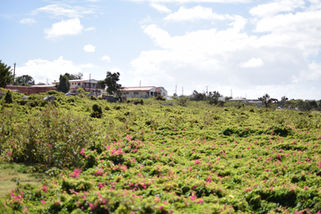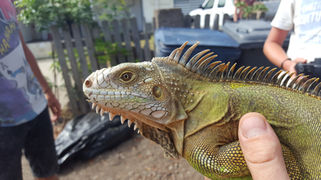
The Lesser Antillean iguana,
Iguana delicatissima
Species Profile.
The Lesser Antillean iguana (Iguana delicatissima) is listed as a critically endangered species on the IUCN Red List. It is a large arboreal (lives mostly in trees) lizard endemic to several islands in the Lesser Antilles. It is one of three species of lizard of the genus iguana, the others being the green iguana (Iguana iguana) and Saban black iguana (Iguana melanoderma). Lesser Antillean iguanas can reach body lengths (snout to vent) of around 45cm, along with a meter long tail. Before they reach this size though, they are tiny when born with a body size of around 7cm. Young iguanas start of completely green in colour, although their tails may already be brown/gray in colour. They will also have several white spots and dashes on the flanks. As the young iguanas mature they will develop a slate gray colour particularly from around the extremities (i.e. their legs and tail) inwards. Unlike their cousins, I. iguana and I. melanoderma, Lesser Antillean iguanas have a completely grey/black tail without any banding. As I. delicatissima age, the males will go completely gray, but females will retain some green colouring. Males especially, will get pink cheeks during the mating season. They also have a more stocky build and will grow slightly larger then the females. The heaviest adult I. delicatissima recorded on St. Eustatius to date was 3,5kg.
Mating season is approximately from January until late march. Eggs are laid around July-August, and the young hatch around October - November. These reproductive stages may differ per island throughout their range.
Lesser Antillean iguanas are completely vegetarian eating leaves and fruits depending on the season. The young are born around the beginning of the rainy season, which is the greenest time on St. Eustatius. This has the benefit of a lot of cover and food. During the rainy season many plants grow new leaves, which are easier to digest for young iguanas.
Range and occurance.
Historically, I. delicatissima is believed to have existed throughout the northern Lesser Antilles ranging from Anguilla to Martinique. The species has experienced dramatic declines since European contact, causing the extirpation (local extinction) of some populations and the severe decline of others.
As a result, the Lesser Antillean Iguana has since been extirpated from Saint-Martin (French and Dutch sides), Antigua, Barbuda, St. Kitts, Nevis, and Marie-Galante. Ongoing surveys conducted on Guadeloupe since 2007 suggest that populations have been extirpated from Grande-Terre and Les Îles des Saintes islets. However, individuals are still present along with Green Iguanas and hybrids on Basse-Terre, but biologically viable populations are most likely extirpated. Based on historical range data, the total population of I. delicatissima has most likely experienced declines of more than 70% since European contact. The Lesser Antillean iguana is therefore listed as a critically endangered species by the IUCN.
Once thought to be present in large numbers on St. Eustatius before European colonization, the population is rapidly declining. Past populations size estimates were about 300 animals in 1992, less than 300 individuals in 2000, and about 425 (275-650) individuals in 2004. A recent population update now estimated to be just a few hundred, and population densities have declined across all habitats on the island since the last assessment in 2004 (Debrot et al. 2013). This is far below the required minimum viable population size of 5,000 animals and means that the Lesser Antillean Iguana is critically endangered on St. Eustatius.
St. Eustatius.
St. Eustatius also known as Statia is a small island of only 21 square kilometers. It is the only island in the Dutch Caribbean where Lesser Antillean iguanas still occur.
National Parks.
There are two national parks called the Quill National Park and Boven National Park. Both parks are run and maintained by the St. Eustatius National Parks (STENAPA). The Quill National Park is a dormant stratovolcano up to 601m high. The name 'Quill' originates from the Dutch word 'kuil' meaning 'pit' or 'hole'. The Quill has a lush rainforest on the crater floor, and is covered in forests on the outer slopes.
Boven National Park is made up of dry tropical forests and savanna-like grasslands. Both national parks are sadly highly degraded due to thousands of roaming animals on the island, that will eat anything edible in reach.
Threats.
Habitat loss and fragmentation were historically most extensive on the least mountainous areas, which were systematically cleared for agriculture. As tourism and other economic growth superseded agriculture in importance, (coastal) development has further reduced the remaining habitat and significantly affected already-limited communal nest-sites (Day et al. 2000). Road casualties occur regularly along roads, which bisect iguana habitat. Lesser Antillean Iguanas are impacted by a range of introduced predators. Predation by both cats and dogs is a large problem. Adult iguanas are known to be killed by guard dogs that run free within fenced properties where iguanas move to feed.
Free-ranging and feral browsing competitors are present on St. Eustatius. Goat, sheep, and cow populations are particularly large and of most concern. Extensively overgrazing continues to cause a shift in plant species composition and habitat structure. Another threat is the ongoing degradation of natural vegetation attributable to the spread of invasive alien species, most notably the Mexican Creeper (Antigonon leptopus.), locally known as corallita, which is unpalatable to both goats and iguanas (Fogarty et al. 2004; Debrot et al. 2013).
Hunting is likely a minor problem, primarily because population densities are so low that it is not worth the effort. Other notable sources of iguana mortality are starvation (or drowning) in abandoned cisterns and entanglement in fencing.
Displacement through competition and hybridization with I. iguana appears to be the dominant factor in the disappearance of the Lesser Antillean Iguanas in the region. This process is rapid and subsequent population extirpations have been recorded from several islands in the French West Indies. Sadly a single green iguana female was discovered in early 2016 on St. Eustatius. A further ten hybrids have been observed since. Hybridization is now considered the main threat for the existence of I. delicatissima throughout its natural range. The introduction of green iguanas and hybrids needs to be prevented at all costs.
Notice the differences.
Iguanas in the Lesser Antilles include only three species; The common Green Iguana (Iguana iguana), the Saban Black iguana (Iguana melanoderma) and the Lesser Antillean Iguana (Iguana delicatissima). For the untrained eye I. iguana and I. delicatissima look quite similar but can be most easily distinguished by the large subtympanic scale that can be found under the jaw on the cheeks and the unmistakable black and green banding of the tail, both typical features of the Green Iguana. Other key features to distinguish the two species are:
-
The common Green Iguana has bands on its tail, whereas the Lesser Antillean Iguana has not.
-
The Lesser Antillean Iguana also has a large number of small scales instead of a single plate below its ear.
-
As the Lesser Antillean Iguana ages, the color of its skin will change from green to a slate grey color, although females sometimes retain some of the green body color.
-
The Lesser Antillean Iguana is also slightly smaller than the common Green Iguana.
-
Reproductively active Lesser Antillean Iguana males and even some females develop distinctly pink cheeks.
-
Skull morphology (Conrad and Norell 2010) and more than 15 morphological characters (Breuil 2013).



















